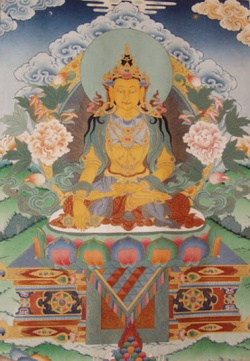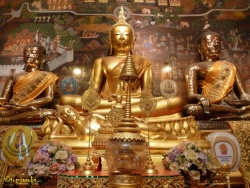The New Kadampa Tradition / Kadampa Buddhism: The Real Danger
GUEST POST by Robert – a former NKT monk
The Real Danger
If you are a scifi fan, you may remember the old television show, ‘Stargate: SG1′, where in the later series there were two races who were said to have transcended the mortal realm: the Ori and the Ancients. The Ori created a book, similar to the Bible, called the ‘Book of Origin’ and they promised their followers perfect enlightenment, if they simply put their unwavering faith in the Ori, and put aside their own intelligence for the ‘Will of the Ori’. The most devout of the Ori followers became like mindless zombies, or shells of the people they once were, who emptied their minds and allowed the Ori to speak through them. Then on the other hand, we had the Ancients, who mainly spoke in apparent riddles, not unlike Zen Koans. In stark contrast to the Ori, the Ancients did not tell their followers anything of the truth, and refused to help them directly, as they believed that human beings must think for themselves and realize the truth for themselves. So they would not help them to ‘ascend’, rather they had to learn for themselves.
These two fictional enlightened races are a great metaphor for two ways we could approach religion or a spiritual tradition. The majority of religions are not too dissimilar to the Ori, in the sense that practitioners are told what to think and how to behave, by following a book. In these religions there is not much room for free-thinking, as they are centred around the concept of faith. All good things are promised to those who have faith, and not for those who harbour doubts or refuse to believe what they are taught. Over time, when one has developed ‘faith’ in their religion, they think for themselves less and less, and rather than relying on answers born from their own contemplation, they refer to answers handed to them by their teacher or written for them in a book. They become like a zombie, or a religious parrot. Like the followers of the Ori, they put aside their own intellect, as a sort of lazy mentality emerges, where all the answers are given to them, so they don’t need to bother to contemplate for themselves.
Buddhism, for the most part, is the healthy alternative, where its practitioners, like the followers of the Ancients, are encouraged to think for themselves and arrive at their own understanding. They are encouraged to look for themselves at the reality of their own minds and see what’s there. Through genuine Buddhism, the mind can become strong and healthy, through seeking out its own understanding.
However, even Buddhists can fall into the Ori’s trap, and this is particularly true for one young tradition, which broke away from its much broader-minded and wiser parent, Tibetan Buddhism. This tradition is called the New Kadampa Tradition, or the NKT.
After it’s break-away from Tibetan Buddhism, the NKT became much more fundamentalist and purist than its predecessor. They removed all books from their Dharma centres that were not written by the NKT Guru, and advised their practitioners to only read their Guru’s books. The NKT wants its followers to have only one source of information on the Dharma, or spiritual truth: their source.
When they choose some of their new followers to becomes teachers, they are instructed to teach directly from these books, and not from any other source of information. They are to put their own understanding aside, and are told to imagine the Guru is speaking through them. Over time, the ‘teacher’ becomes like a mindless parrot, with no understanding of their own to share and only speaking the words they have been told to speak. When they are asked a question about the Dharma, they do not refer to their own understanding, but will often begin their thoughts and speech with “my Guru says.”
If a student ever questions or doubts the teaching of the Guru, they are told that their own mind is impure and deluded, so their own intellect is unreliable, and that they must rely on the Guru’s wisdom instead, as he is enlightened. In this way, students of the NKT gradually learn to think less and less for themselves, as they steadily increase their faith in the Guru’s wisdom. Eventually, they never harbour doubts in their mind, as they perceive their own mind as being deluded and unreliable, so they never take their doubts or questions seriously, and always fall back to their ‘faith’ in the Guru.
This is further enforced through manipulation of the students through fear. There is something I forgot to mention about the Ori: those who refuse to put their faith in them are simply destroyed. This is not so different from the NKT’s brand of fear manipulation. Early on in the student’s learning, they are taught to rely on the Guru, and they are also taught that those who abandon the Guru, or break their vows, will create the horrible karma to be reborn in a violent hell realm for a near-infinite period of time. They are also taught that for every moment of doubt that arises in their minds, they are creating a future in hell for themselves. Over time, these beliefs become ingrained in the student’s mind and they come to really believe these statements to be true. So the student does not dare to doubt the Guru, or to leave the tradition, out of a very real fear of hell.
I don’t think I have to connect the dots any further for the reader, as it is clear to see the blatant and horrifying similarities between the New Kadampa Tradition and the Ori. This, I feel, is the real danger of getting involved with this tradition. It is a great shame, that those sincerely interested in Buddhism, may stumble upon this tradition first and not recognize the difference between it and genuine Buddhism. This is a very real threat as well, as no tradition has expanded at the rate the NKT has. Almost every city and major town in England now has an NKT centre, and even the surrounding towns have branch classes, stretching out from the parent centres. This is due to the large amount of income the NKT receives, through donations from its students, excessive fees for its meditation and Buddhism classes, its festivals, Dharma shops and even hotels and other businesses.
Just like the Ancients of Stargate: SG1, the Buddha’s true intention for us, was for our minds to grow strong, through thinking and questioning things for ourselves, through doubting things not blindly believing them, through doing the work for ourselves, looking and seeing what is the reality or the truth of our own minds and the world we live in. The Buddha wanted us to “come and see”, not just believe what he has told us out of laziness or fear. The Buddha himself grew up in a time where the people put their blind faith in books and superstitions, just like the followers of the Ori, but the Buddha was the one who questioned things, who doubted what he was told. His mind grew strong through thinking and looking for himself, and he wanted everyone else, including you and I, to do the same.
Thank you for reading,
Robert

